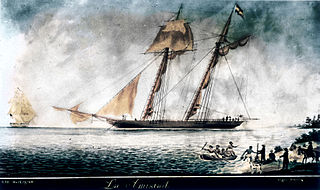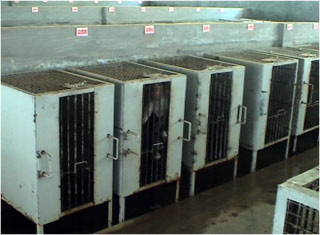
The Middle Passage was the stage of the Atlantic slave trade in which millions of enslaved Africans were transported to the Americas as part of the triangular slave trade. Ships departed Europe for African markets with manufactured goods, which were then traded for slaves with rulers of African states and other African slave traders. Slave ships transported the slaves across the Atlantic. The proceeds from selling slaves were then used to buy products such as furs and hides, tobacco, sugar, rum, and raw materials, which would be transported back to Europe to complete the triangle.

Hindalco Industries Limited an Indian aluminium and copper manufacturing company, is a subsidiary of the Aditya Birla Group. Its headquarters are at Mumbai, Maharashtra, India.
In economics, the market mechanism is a mechanism by which the use of money exchanged by buyers and sellers with an open and understood system of value and time trade-offs in a market tends to optimize distribution of goods and services in at least some ways. The mechanism can exist in free markets or in captive or controlling markets seek to use supply and demand, or some other form of charging for scarcity, to choose among production possibilities. In a free market economy, all the resources are allocated by the private sector ; in a planned economy, all the resources are owned by the public sector ; and, in a mixed economy, some resources are owned by both sectors, private and public. In reality the first two are mostly theoretical and the third is common. Resources are allocated according to the forces of supply and demand.

The Royal, Celestial and Military Order of Our Lady of Mercy and the Redemption of the Captives, also known as the Mercedarians, is a Catholic mendicant order established in 1218 by Peter Nolasco in the city of Barcelona, at that time the capital of the Principality of Catalonia, part of the Crown of Aragon, for the redemption of Christian captives. Its members are most commonly known as Mercedarian friars or nuns. One of the distinguishing marks of the Order of the Blessed Virgin Mary of Mercy is that, since its foundation, its members are required to take a fourth vow: to die, if necessary, for another who is in danger of losing their faith. The Order exists today in 17 countries.

The Calcutta Electric Supply Corporation (CESC) is the Kolkata-based flagship company of the RP-Sanjiv Goenka Group, born from the erstwhile RPG Group, under the chairmanship of businessman Sanjiv Goenka. It is an Indian electricity generation and the sole distribution company serving 567 square kilometres (219 sq mi) of area administered by the Kolkata municipal corporation, in the city of Kolkata, as well as parts of Howrah, Hooghly, 24 Parganas (North) and 24 Parganas (South) districts in the state of West Bengal. It also serves power distribution in Kota, Bikaner and Bharatpur in Rajasthan under the name CESC RAJASTHAN. It serves 3.0 million consumers approximately, which includes domestic, industrial and commercial users.

La Amistad was a 19th-century two-masted schooner owned by a Spaniard living in Cuba. It became renowned in July 1839 for a slave revolt by Mende captives who had been captured and sold to European slave traders and illegally transported by a Portuguese ship from West Africa to Cuba, in violation of European treaties against the Atlantic slave trade. Spanish plantation owners Don José Ruiz and Don Pedro Montes bought 53 captives in Havana, Cuba, including four children, and were transporting them on the ship to their plantations near Puerto Príncipe. The revolt began after the schooner's cook jokingly told the slaves that they were to be "killed, salted, and cooked." Sengbe Pieh unshackled himself and the others on the third day and started the revolt. They took control of the ship, killing the captain and the cook. Two Africans were also killed in the melee.

Kerala State Electricity Board (KSEB) is an Indian public sector undertaking under the Government of Kerala that generates, transmits and distributes electricity in the state under government monopoly. Established in 1957, the agency comes under the authority of the Department of Power. It has been registered under Indian Companies Act 1956 in January 2011.

The Battle of Athens was an American Civil War skirmish that took place in northeast Missouri in 1861 near present-day Revere and southeast Iowa along the Des Moines River across from Croton. The Union victory has the distinction of being the most northerly of Civil War Battles fought west of the Mississippi, and also of being the only such battle fought along the Iowa border.

Damodar Valley Corporation (DVC) is a statutory body which operates in the Damodar River area of West Bengal and Jharkhand states of India to handle the Damodar Valley Project, the first multipurpose river valley project of independent India. Indian Astrophysicist Meghnad Saha, the former chief architect of river planning in India, prepared the original plan for the Damodar Valley Project. It operates both thermal power stations and hydel power stations under the ownership of Ministry of Power, Government of India. DVC is headquartered in the Kolkata city of West Bengal, India.

Nafovanny in Vietnam is the largest captive-breeding primate facility in the world, supplying long-tailed macaques to animal testing laboratories, including Huntingdon Life Sciences in the UK and Covance in Germany.

Mangalore Chemicals & Fertilizers Limited is the largest manufacturer of chemical fertilizers in the state of Karnataka, India. The company is part of the Adventz Group. The company's corporate and registered office is at UB City, Bangalore and its factory unit is in Panambur, north of Mangalore.
The Battle of North Fork or the Battle of the North Fork of the Red River occurred on September 28, 1872, near McClellan Creek in Gray County, Texas, United States. A monument on that spot marks the site of the battle between the Comanche Indians under Kai-Wotche and Mow-way and a detachment of cavalry and scouts under U.S. Army Colonel Ranald S. Mackenzie. There was an accusation that the battle was really an attempt "to make a massacre," as during the height of battle some noncombatants were wounded while mixed in with warriors.

KIOCL Limited, formerly Kudremukh Iron Ore Company Limited, is a central public sector undertaking under the ownership of the Ministry of Steel, Government of India, with its head office and administrative activities in Bangalore. It has a pelletisation plant in Mangalore and an iron ore mine in Kudremukh. The Kudremukh mine, one of the largest iron ore mines in the world, was closed in 2006.
Captive insurance is an alternative to self-insurance in which a parent group or groups create a licensed insurance company to provide coverage for itself. The main purpose of doing so is to avoid using traditional commercial insurance companies, which have volatile pricing and may not meet the specific needs of the company. By creating their own insurance company, the parent company can reduce their costs, insure difficult risks, have direct access to reinsurance markets, and increase cash flow. When a company creates a captive they are indirectly able to evaluate the risks of subsidiaries, write policies, set premiums and ultimately either return unused funds in the form of profits, or invest them for future claim payouts. Captive insurance companies sometimes insure the risks of the group's customers. This is an alternative form of risk management that is becoming a more practical and popular means through which companies can protect themselves financially while having more control over how they are insured.

The Tamil Nadu Newsprint and Papers Limited (TNPL) is a company that was established by the Government of Tamil Nadu to produce newsprint and writing paper using bagasse, a sugarcane residue. The Government of Tamil Nadu listed the paper mill in April 1979 under the provisions of the Companies Act of 1956. The factory is situated at Kagithapuram 11.0488°N 77.9977°E in the Karur District of Tamil Nadu and Manapparai, Trichy district of Tamil Nadu. The registered office of the company is located in Guindy, Chennai.

NSPCL is a joint venture of National Thermal Power Corporation and Steel Authority of India Limited. engaged in power generation primarily to meet the captive power requirement of various steel plants of SAIL throughout India. It is one of the institutional category III profit making Indian PSEs.
Odisha Power Generation Corporation Limited (OPGC) is the only thermal power generating company owned by the Government of Odisha. It was incorporated under the Companies Act 1956 on 14 November 1984. OPGC started as a solely owned Government Company of the state of Odisha. It owns and operates four units of power plant- 2 units of 210 MW each and 2 units of 660 MW, each totaling a generation capacity of 1740 MW of power at Ib Thermal Power Station (ITPS), Banharpali in Jharsuguda District of Odisha. The generation from these units is committed to GRIDCO on the basis of a long-term Power Purchase Agreement.
BPSCL Power Plant is a coal-based thermal power plant located in Bokaro district in the Indian state of Jharkhand. The power plant is owned by Bokaro Power Supply Company Limited, a joint venture between Steel Authority of India and Damodar Valley Corporation. It supplies power and process steam to Bokaro Steel Plant and surplus power to grid.
The NSPCL Bhilai Power Plant is a coal-fired captive power station at Bhilai in Durg district, Chhattisgarh, India. The power station owned and operated by NSPCL is a 50:50 joint venture company of NTPC Limited and SAIL to generate power for captive purposes of various steel plants owned by SAIL.
A captive power plant, also called autoproducer or embedded generation, is an electricity generation facility used and managed by an industrial or commercial energy user for their own energy consumption. Captive power plants can operate off-grid or they can be connected to the electric grid to exchange excess generation.











